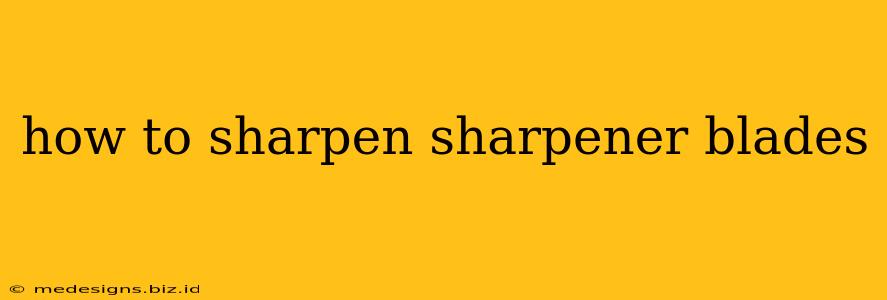So, your sharpener isn't so sharp anymore? Don't toss it! Learning how to sharpen sharpener blades can save you money and keep your knives in peak condition. This guide provides simple methods to restore the cutting edge to your beloved sharpening tool.
Understanding Your Sharpener Type
Before diving in, identify your sharpener type. Different sharpeners require different sharpening techniques. Common types include:
- Pull-through sharpeners: These are generally the most common and easiest to use. They often have fixed abrasive slots.
- Electric sharpeners: These offer speed and convenience but require a different approach to sharpening the blades themselves.
- Honing steels: While not strictly sharpeners, honing steels realign the blade's edge, and may need occasional attention.
- Whetstones: These require more skill but offer ultimate control and precision in sharpening.
Sharpening Pull-Through Sharpeners
Pull-through sharpeners typically use ceramic or diamond rods. These rods can dull over time. Unfortunately, sharpening these embedded rods directly is usually impossible. Your best option is replacement. Look for replacement parts online or at kitchen supply stores. Many manufacturers offer replacement rods specifically designed for their sharpeners. Check your sharpener's manual for compatibility.
Signs Your Pull-Through Sharpener Needs Attention:
- Knives feel dull after sharpening: This is the most obvious sign.
- Increased sharpening effort: You need to pull your knife through the slots multiple times to achieve a sharp edge.
- Visible wear on the ceramic or diamond rods: Look for noticeable chipping, dulling, or significant wear on the sharpening surfaces.
Sharpening Electric Sharpeners
Electric sharpeners often feature multiple stages, which may require separate sharpening stones. The exact method of sharpening the stones within these devices varies greatly by the manufacturer and model. Consult your owner's manual. Some may allow for replacement of grinding wheels or sharpening stones. Others might require professional servicing or complete replacement of the unit.
Signs Your Electric Sharpener Needs Attention:
- Knives are not as sharp as they used to be.
- The sharpener makes unusual noises during use. This could signal worn or damaged components.
- The motor seems to struggle or overheat during operation.
Sharpening Honing Steels
Honing steels primarily realign the blade's edge, not sharpen it. While they don't typically require sharpening themselves, they can become dull over extended use. Instead of sharpening, focus on cleaning and maintaining your honing steel.
- Regular cleaning: Wipe the steel clean after each use to remove metal shavings.
- Proper storage: Store your honing steel in a safe, dry place.
Sharpening Whetstones (Advanced)
Sharpening whetstones requires skill and practice. If your whetstones are dull, you'll need to use a lapping plate to flatten and re-profile the surface. This process involves using a coarse lapping compound to remove uneven wear and restore the flat surface of the whetstone. This method is best for experienced users.
Maintaining Your Sharpener
Regular maintenance extends the lifespan of your sharpener significantly. This includes:
- Cleaning: Remove metal shavings and debris after each use.
- Proper storage: Store your sharpener in a safe, dry place to prevent rust and damage.
- Careful usage: Avoid excessive force when sharpening your knives.
By following these guidelines, you'll keep your sharpener sharp and your knives ready for any culinary task. Remember to always consult your sharpener's manual for specific instructions and recommendations.
